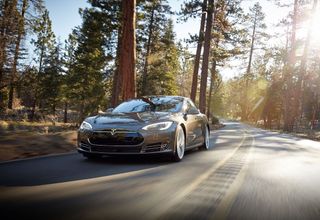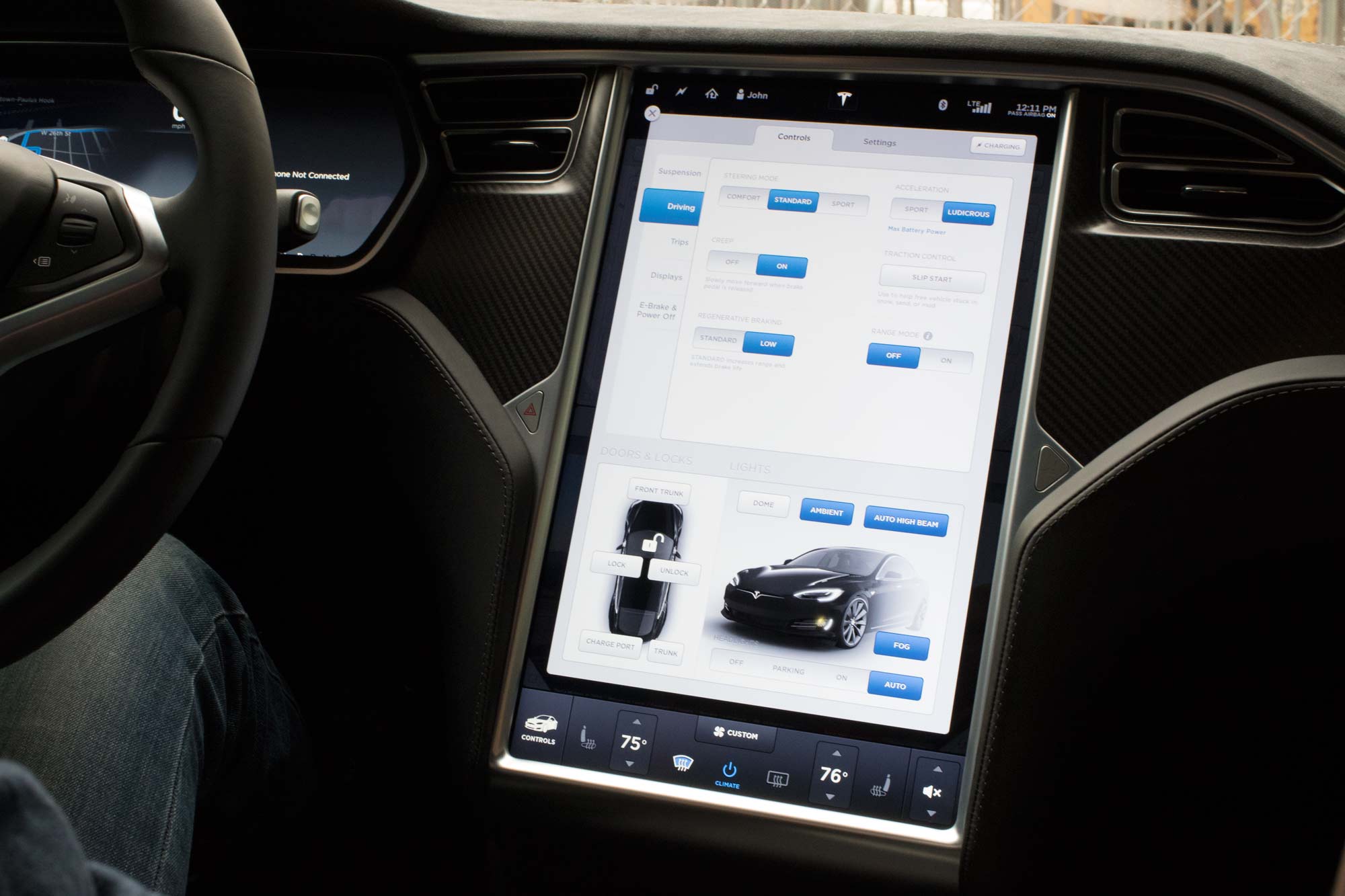How to Use Tesla's Autopilot (and How Not to)
How to Use Tesla's Autopilot (and How Not to)

Although the latest semiautonomous driving technologies have the potential to save lives, the tragic accident involving a Tesla Model Due south in Autopilot mode underscored that they can likewise cause defoliation that tin can result in fatalities. While the National Highway Traffic Prophylactic Administration continues its investigation into the blow that killed Tesla possessor Joshua Brownish, many people accept had questions most how Tesla'southward Autopilot should exist used.
When properly employed, Autopilot, which can automatically steer and brake a Tesla Model Due south or Model X, can exist an important driver help feature. But for it to enhance rubber, drivers need to understand its limits and learn how to use information technology.
What Autopilot does
Autopilot uses forward-facing radar and a photographic camera to watch for obstructions, traffic and lane markings ahead. Information technology likewise uses a serial of ultrasonic sensors around the car to notice nearby vehicles. Together, it tin literally drive a vehicle downwards a highway without any commuter input. Tesla tells drivers not to accept their hands off the wheel, only it is possible to practice so for up to a couple of minutes before the system shuts off and the car slows downward. Other similar systems on BMW, Mercedes-Benz and Volvo vehicles allow you to take your easily off the wheel for only 16 seconds or less.

Autopilot is also designed to gather data most roads Tesla owners are driving on. In other words, it will record when a driver has to take over from the Autopilot software or has a sudden braking incident, presumably to map that data and hopefully amend the software'due south driving skills. A sharp turn might be noted and then used to update the software and so that the next Tesla vehicle traveling on that route can anticipate the corner the adjacent time.
While this information could be helpful in the future, there are not plenty Tesla vehicles currently on highways for it to make a significant divergence today. Consider that it takes hundreds of millions of drivers to give Waze a reasonable level of accuracy in providing simple traffic information.
Warnings
Warnings — in that location are lots of warnings. Right from the showtime, whether you're looking at the owner's manual or the on-screen prompts in the car, Tesla points out that Autopilot and the subservient Autosteer programs are in beta. That means they take non been fully tested and are not considered set up for last release. There are warnings on-screen when you ready upward the organisation and warnings in the dash when you engage Autopilot.

In other words, ignore the showboating videos you've seen, and do not ever read a newspaper or eat a ham sandwich while yous're behind the wheel.
How to appoint
Autopilot is really the combination of two features: Traffic-Aware Cruise Control (TACC) and Autosteering. The old is a souped-up version of adaptive cruise control that's available in most cars. Tesla'due south wrinkle is to use ultrasonic sensors around the car to lookout for nearby vehicles that might verge into your lane. The Autosteering feature watches the lane markings and objects in front of the car using the camera and radar.
So when you lot initially use the organization, under the Settings tab you'll observe the Driver Assistance menu on the main center stack screen where you should adjust the settings for Autosteering and TACC, including how nigh or far you desire to follow other cars. When y'all turn on Autosteering here, over again, you lot'll receive a warning virtually keeping your hands on the wheel.
Autopilot is still not engaged until you lot striking cruising speed, set prowl control and turn it on. You practice so by doing two quick pulls on the left paw stalk. To ostend you're in Autopilot mode, you'll see the Autosteering wheel icon plough blue in the driver's display. Loosen your grip on the wheel, and you'll sense resistance from the steering wheel and then feel the car steering itself.
How to use it
While using Autopilot, you should take your feet off the pedals (simply next to them) and your hands lightly on the steering bicycle. Always remain alert, looking ahead equally if the system were not engaged at all. Again, the software is in beta, and it is not designed to fully drive the auto. While it volition brake automatically, it does not recognize traffic lights or look farther downward the road to conceptualize sudden congestion. In other words, if you're traveling at 65 mph and there'south traffic stopped immediately ahead, it will not typically be able to stop in time. Autopilot cannot overcome the laws of physics, and so drivers need to remain circumspect.

Practice is too advisable. The Autosteering software has been adjusted to err on the side of circumspection in that it tends not to predict whether the lane ahead is going to be straight or have a particular curve. And so the automobile tin tend to wander inside the lane, depending on how visible the lines on the road are. Information technology takes some practice to get comfortable using it and to empathise when the car is just making minor adjustments or is about to veer out of the lane. In some ways, it'southward like learning how to drive over again.
More: Continued Cars: A Guide to New Vehicle Technology
1 additional feature of Autopilot is Auto Lane Alter. To use this characteristic properly, yous should bank check to make sure that the lane yous want to move into is clear, so utilize your turn signal. The auto will utilise its sensors then will move over smoothly into the next lane and automatically shut off the turn signal — and it will return to the speed y'all originally prepare in cruise control.
The last point is important because, if y'all take been following a slower car for several minutes, and then yous switch into an open lane, the car volition begin accelerating over again to bring you up to speed. If you lot're in a structure zone or about to exit the highway, y'all'll need to stay aware and brake accordingly.
Where not to use Autopilot
At that place is no lower speed limit, simply Autopilot is designed for highway use, so never utilize it on other roads. Tesla makes this articulate and advises that the Autopilot system should non be used on secondary roads, significant anything with intersections, traffic lights, or unmarked or inconsistently marked lanes.
The system is as well best suited for wider highways with four or more lanes. 2-lane roads, even clearly marked ones, brand information technology too easy for the car to veer off slightly into oncoming traffic, which requires quick commuter reflexes to recoup. Furthermore, at that place are oftentimes stationary obstructions, such every bit double-parked trucks, on secondary roads. And Tesla specifically warns that such objects may non be detected by the Traffic-Aware Cruise Control and could cause an accident.
2-lane highways, and highways like the one where Dark-brown had his fatal accident, also have besides many intersections and entry points. A vehicle suddenly turning into the road or turning across your lane may non be detected in fourth dimension for the vehicle to stop. You, the driver, have to stay enlightened and anticipate such events.
When it goes off
The trickiest office of using Autopilot is realizing when it has switched itself off. If you lot disregard all the advice and warnings and take your hands off the wheel for more than a couple of minutes, the auto's nuance will warn you lot with a chinkle and display an alarm that y'all have to put your hands on the wheel. If you persist in disregarding the warnings, the motorcar will begin slowing downwardly.
The existent problem occurs once you've go comfortable using Autopilot and it turns off without you noticing the change. It can do so if it cannot clearly observe lane markings, for example. A chime sounds, the steering wheel icon goes gray and the steering loosens upward. However, if you've become distracted and don't observe the alerts (which I constitute was easy to do), you may non realize the system is off until it fails to negotiate the next curve.
MORE: How to Crash a Self-Driving Car
Some other typical state of affairs in which Autopilot may shut off is if yous inadvertently push too difficult on the wheel (remember, your easily should be on it at all times). I often observe that the Autopilot takes me too close to the middle or left-manus lane marker for my gustatory modality. (On the other hand, some other vehicles frequently have me likewise shut to the right-hand lane edge for my comfort level.) Consequently, I often have tugged the wheel dorsum, and that disengages Autopilot.
When used judiciously, Tesla'southward Autopilot tin be a smashing help to drivers, particularly on long trips. It tin can help alleviate driver fatigue, for case and, in situations where one might be momentarily distracted, prevent a serious collision. But information technology's critical that drivers understand its limitations and heed all warnings.
Source: https://www.tomsguide.com/us/how-to-use-tesla-autopilot,review-3870.html
Posted by: yeearoult.blogspot.com


0 Response to "How to Use Tesla's Autopilot (and How Not to)"
Post a Comment